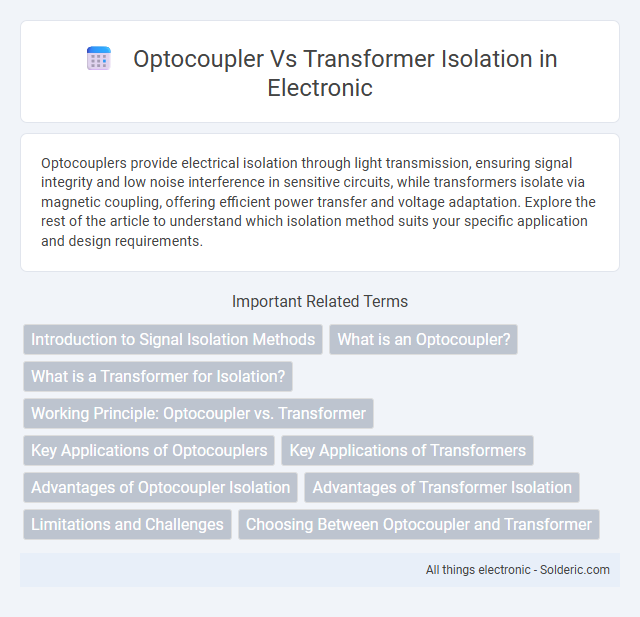Optocouplers provide electrical isolation through light transmission, ensuring signal integrity and low noise interference in sensitive circuits, while transformers isolate via magnetic coupling, offering efficient power transfer and voltage adaptation. Explore the rest of the article to understand which isolation method suits your specific application and design requirements.
Comparison Table
| Feature | Optocoupler Isolation | Transformer Isolation |
|---|---|---|
| Working Principle | Light transmission via LED and photodetector | Electromagnetic induction between coils |
| Galvanic Isolation Voltage | Typically 3750 Vrms to 5000 Vrms | Up to 10 kV or higher depending on design |
| Signal Type | Primarily digital, low-speed analog | AC signals, power transfer, and analog signals |
| Frequency Response | Up to a few MHz | From DC (with special transformers) to GHz range |
| Size & Weight | Compact, lightweight | Generally larger and heavier |
| Power Consumption | Low input power, LED forward current required | No power consumption, passive device |
| Linearity | Non-linear, requires calibration for analog | High linearity for analog signals |
| Cost | Low to moderate cost | Moderate to high cost |
| Lifespan & Reliability | Limited LED life, sensitive to temperature | Long lifespan, robust in harsh environments |
| Typical Applications | Digital signal isolation, microcontroller interface | Power supply isolation, audio transformers, RF isolation |
Introduction to Signal Isolation Methods
Signal isolation methods like optocouplers and transformers provide crucial electrical separation between input and output circuits to prevent noise, voltage spikes, and ground loops. Optocouplers utilize light signals to transfer data across an isolation barrier, offering high-speed switching and compact design ideal for low-power applications. Transformers isolate signals through magnetic coupling, delivering galvanic isolation with the ability to handle higher power levels and AC signals efficiently.
What is an Optocoupler?
An optocoupler, also known as an optoisolator, is a semiconductor device that transfers electrical signals between two isolated circuits using light. It consists of an LED that emits infrared light and a photodetector that senses this light to reproduce the signal without direct electrical connection, providing excellent isolation and noise immunity. Your circuits benefit from optocouplers by achieving safe signal transmission in applications requiring isolation from high voltages or noisy environments.
What is a Transformer for Isolation?
A transformer for isolation is an electromagnetic device designed to transfer electrical energy between two or more circuits while maintaining galvanic isolation, preventing direct electrical connection and enhancing safety. It works by using magnetic induction between primary and secondary windings, which allows signal or power transfer without conductive contact. Your choice between an optocoupler and transformer isolation depends on voltage level, frequency, size, and the need for noise immunity in your application.
Working Principle: Optocoupler vs. Transformer
An optocoupler isolates signals using light emitted by an LED and detected by a phototransistor or photodiode, converting electrical signals into optical signals and back, ensuring galvanic isolation between input and output. A transformer isolates circuits through electromagnetic induction between primary and secondary coils, transferring energy via a magnetic field without direct electrical connection. Your choice depends on signal type, frequency response, and isolation voltage requirements.
Key Applications of Optocouplers
Optocouplers are widely used in signal isolation for microcontroller interfaces, preventing high voltage spikes from damaging sensitive electronics. They provide precise electrical isolation in medical devices and industrial automation systems, enhancing safety and noise immunity. Their compact size and fast switching capabilities make them ideal for use in data communication and power supply feedback circuits.
Key Applications of Transformers
Transformers are extensively used in power supplies, signal isolation, and impedance matching due to their ability to provide galvanic isolation while transferring power efficiently. They are crucial in applications such as AC/DC converters, voltage scaling in power grids, and audio systems to prevent ground loops and minimize noise. Their robust isolation capabilities make them ideal for high-voltage environments and industrial equipment requiring reliable electrical separation.
Advantages of Optocoupler Isolation
Optocoupler isolation offers superior electrical noise immunity and compact design compared to transformer isolation, making it ideal for low-voltage signal transmission. It provides excellent high-frequency response and galvanic isolation, ensuring reliable protection of your sensitive electronics from voltage spikes and ground loops. The solid-state nature of optocouplers also results in longer lifespan and greater reliability in harsh environments.
Advantages of Transformer Isolation
Transformer isolation provides galvanic isolation with high voltage tolerance, making it ideal for protecting sensitive circuits from voltage spikes and electrical noise. It enables efficient power transfer and signal integrity over a wide frequency range without direct electrical connection. Transformers also offer better common-mode noise rejection and can handle higher power levels compared to optocouplers, ensuring reliable isolation in industrial and high-power applications.
Limitations and Challenges
Optocoupler isolation faces limitations such as bandwidth constraints, slower response times, and potential signal degradation due to LED aging or photodetector sensitivity variation. Transformer isolation encounters challenges including core saturation, size and weight issues for low-frequency signals, and susceptibility to electromagnetic interference (EMI). Both methods require careful design considerations to ensure reliable isolation performance in high-voltage and high-frequency applications.
Choosing Between Optocoupler and Transformer
Choosing between optocoupler and transformer isolation depends on factors such as signal type, isolation voltage, and frequency response. Optocouplers excel in low-frequency, low-power digital signal isolation with compact size and low cost, while transformers provide robust isolation for high-frequency AC signals and power transfer. For sensitive analog signals or power electronics, transformers offer better performance and higher voltage isolation ratings compared to optocouplers.
optocoupler vs transformer isolation Infographic

 solderic.com
solderic.com